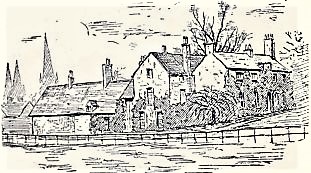Summary. Around 1237 a Franciscan Friary was built on Sandford Street, now St John Street. After a fire in 1286, much of the Friary was rebuilt in stone and the church was nearly three-quarters the length of the cathedral. All was demolished after the Reformation.
The Franciscans were founded in 1209 by St. Francis of Assisi, 1181–1226. To begin with the Catholic order required Friars to observe extreme poverty, having to beg for food when preaching, but this was relaxed in 1223. Around this time Friars came to England. It was probably Bishop Alexander Stavensby,1224–1238, who instigated a Franciscan Friary, c. 1237,[1] in the town by giving free burgage plots for the friars to set their house on. The bishop supported King Henry III who favoured Franciscan monks. The king allowed oaks to be cut from neighbouring forests to build a church. The Sheriff of Lichfield was authorised in 1241 ‘to clothe the Friars of Lichfield.’ In 1286, Edward I provided eight oak trees from Cannock Chase for further building. A date of c. 1286 has been given for completion of the church, most likely wooden, and all the associated buildings.[2] A fire destroyed much of the town and some say the original church on 4 May 1291.[3] The friary was rebuilt in stone and with extra buildings expanded over an area of 12 acres. Presumably builders in the last stages of constructing the cathedral helped or advised on building a large friary church.
 |
| Wall plaque giving approximate dates. |
 |
The Franciscan ‘Grey Friars’[4]
were noted for poverty, simple living and caring for the unwell in the
Community, which earned gratitude from the residents of the town. Many
donations for the upkeep of the friary were recorded.
Possible layout for Lichfield Friary. The church has a similar unusual
compass inclination as the cathedral. It is presumed the tower and spire were
at the crossing, with a spire similar in height to the cathedral, c. 60 m. Its
length is estimated to be 60-70 m. The right to pipe water was given in 1301
and the water was given for free. It is thought the water passed through wooden
(alder) pipes. Three tanning pits have been found and either they preceded the
Friary or were part of the friary workshops.
Artistic reconstruction of the Friary as depicted on Lichfield District
Council city visitor board. Also, Wikipedia.
 |
| 1638 Map of the Friary site.[8] |
Drawing of
surviving buildings known as The Friary,[7]
Bassett believed the Friary site interrupted an important through-route along Bore Street which was diverted along one end of ‘Friars Alley’ before returning to its original line.[9] The church lay along this important route and it is suggested this originally straight route was the high-street of the town. Bassett also suggested the Friary had two cloisters with an earlier, smaller cloister against the choir.
[1]
Some accounts have 1229. There is no certainty Bishop Stavensby gave the land
for a friary, see G C Baugh et al, 'Friaries: The Franciscan friars of
Lichfield', in A History of the County of Stafford: Volume 3, ed. M
W Greenslade and R B Pugh (London, 1970), 268-270.
[2]
T. Harwood, The history and antiquities of
the church and city of Lichfield.
(London: 1806), 481 was of the opinion it had a fine Gothic appearance, with
massive gates, thick walls, and windows of coloured glass. Three fields or
pastures on the west part of the Lodging were commonly called the Barr Plecke,
the Colyers Plecke, and the Orchard. A watercourse ran from a place called Poole-furlong(e)
to the Crucifix (water outlet) in Lichfield Streete. The water pipes and outlet
still exists, though rebuilt. Poole furlong could be at Aldershawe or more
likely along the Trunkfield brook. Another source of water mentioned was
Fowlewell, near Aldershawe.
[3]
H. Wharton, Anglia Sacra, Volume 1. (London: 1691), stated ‘the city of
Lichfield and the entire house of the Friars Minor were burned’. Harwood
(1806), see note 2, wrote most of the town was destroyed, but not the church.
Bassett (1980), 105, note 18, indicated that Harwood could have been correct.
The church was some distance from the rest of the town.
[4]
They were later called Grey-Friars, from their habit, which, in imitation of
their founder, was a long grey coat down to their heels with a cowl or hood and
a cord or rope about their loins, instead of a girdle. The friar’s cowl was in
the shape of a bag, narrowing towards the end. It was fastened to the upper
part of the coat behind and was hung ready to cover the head, or to fill with
provisions, or with whatever they might receive in their supplications from
house to house. Harwood (1806), 481 see note 2.
[5] Letters and Papers Henry VIII Volume 13, part 2 August 1538 section 6-10. By the time of the Dissolution of the religious orders in the 1530s approximately 189 friaries had been founded for a number of different groups of friars, each with their individual missions.
[6]
C. Upton, A history of Lichfield, (Stroud: 2001), 42.
[7]
H. Snowden Ward, Lichfield and its cathedral: A brief history and guide. (Bradford:
1893), 18.
[8]
J. Hill map from plate 7 in Harwood (1806), 480, see note 2.
[9]
S. R. Bassett, ‘Medieval Lichfield: A topographical review’. Staffordshire
Archaeological and Historical Society Transactions, (1980), 22, 104.




No comments:
Post a Comment